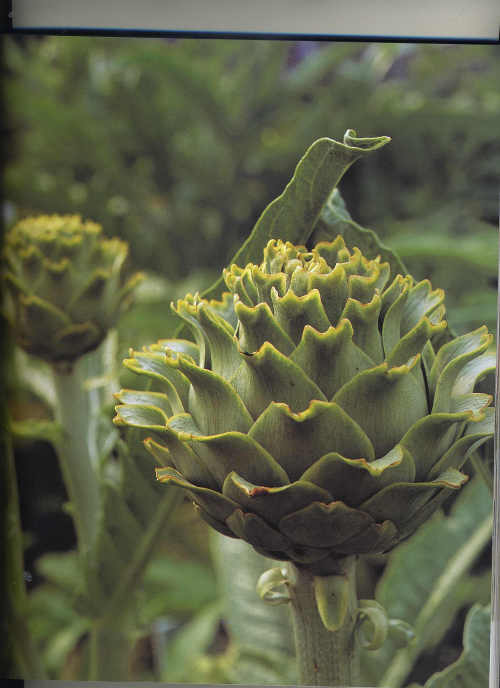In Season - Globe Artichokes
 Georgina Campbell
Georgina Campbell
On our travels this summer I’ve been surprised to see that wintry favourite, Jerusalem artichoke, on a number of menus where seasonality is usually observed.
Perhaps chefs are somehow confusing them with the splendid globe artichoke (Cynara scolymus) the handsome architectural member of the thistle family that is a cultivated form of the cardoon, and in season now.
Although mainly grown for the large edible flower buds, it is very worthwhile to allow some buds to mature if they are growing abundantly as the beautiful thistle-like purple flowers are quite spectacular, both as a garden feature and for cutting.
They can be grown in all areas if the variety is carefully chosen (‘Vert de Laon’ is hardy) but really thrive in the milder south-western counties of Ireland and Britain and my father always had an abundance of them for both the table and the house in his lovely Cornish garden.
Even if grown from seed they should flower in the first season, and will grow larger and more prolific for several years if well fed and protected from frost if necessary, although they do need to be divided and replanted to maintain a vigorous stock.
The easiest way to cook and serve globe artichokes is to trim the stem and then to boil or steam the whole immature flower heads until the scales pull away easily from the base.
Served whole but with the ‘choke’ - which is the immature flower - removed, you simply pull out the individual ‘petals’ and dip them into a sauce of melted butter, vinaigrette or Hollandaise, then suck the delicious juicy flesh from the base of each one; finally cut out the hearts (also known as ‘fonds d’artichaut’) and enjoy them with any remaining sauce and some crusty bread. It’s a lovely sociable summery ceremony, with lots of fingers licking and all the ‘petals’ ending up in a big bowl on the table.
There are of course many other ways to serve this versatile delicacy, including Globe Artichoke Hearts Braised in Olive Oil, a more refined recipe from Darina Allen’s book A Year At Ballymaloe Cookery School (1997; Kyle Cathie paperback edition 2007).
“Ireland has a great climate for globe artichokes. Fields of them make one of the more bizarre sights which greet tourists on the Beara peninsula. Our variety has been handed down through generations of Myrtle Allen's family. We mostly eat them whole, dripping with melted butter or Hollandaise. We grow so many that by the time August comes we get more flahulach with them and just eat the hearts.”
SERVES 4
900 ml (11/2 pints) water
1 lemon
6 globe artichokes
1 onion, coarsely diced
6 tablespoons extra virgin olive oil
2 cloves garlic, chopped
4 tablespoons coarsely chopped parsley
Salt and freshly ground black pepper
Preparing the artichokes is the fiddliest part of this recipe. Acidulate the water with the juice of the lemon. Drop in the squeezed lemon halves too.
Cut a ring around the stalk where it meets the base of the artichoke. Break off the stalk and the toughest fibres will come with it. Then, with a sharp knife, starting from the base, ruthlessly cut off all the leaves and trim the top down as far as the heart.
Scrape out the hairy choke, either with the tip of a knife or a sharp-edged spoon. Work quickly and drop the trimmed hearts into the acidulated water immediately, or they will discolour.
Chop the onion into large dice. Heat the oil in a wide sauté pan, add the chopped onion and garlic and sweat for a few minutes. Cut the artichoke hearts into quarters or eighths, add to the pan with the chopped parsley.
Season with salt and freshly ground pepper and toss well. Add 60ml (21/2 fl oz) water, cover and cook for 10-15 minutes, until the artichokes are tender. Serve hot or at room temperature.






There are currently no comments
Leave a comment
Not a member? Register for your free membership now!
Or leave a comment by logging in with: